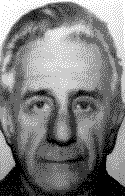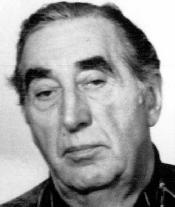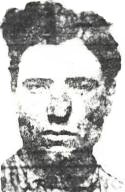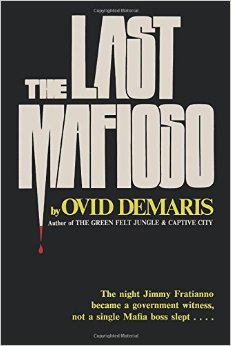Related Research Articles

Lester Ben Binion, better known as Benny Binion, was an American career criminal who established illegal gambling operations in the Dallas-Fort Worth area. In 1931, Binion was convicted of shooting and killing a rum-runner, Frank Bolding. In the 1940s he relocated to Nevada, where gambling was legal, and opened the successful Binion's Horseshoe casino in downtown Las Vegas.
Morris Barney Dalitz was an American gangster, businessman, casino owner, and philanthropist. He was one of the major figures who shaped Las Vegas in the 20th century. He was often referred to as "Mr. Las Vegas".
The Irish Mob is a usually crime family–based ethnic collective of organized crime syndicates composed of primarily ethnic Irish members which operate primarily in Ireland, the United States, the United Kingdom, Canada and Australia, and have been in existence since the early 19th century. Originating in Irish-American street gangs – famously first depicted in Herbert Asbury's 1927 book, The Gangs of New York – the Irish Mob has appeared in most major U.S. and Canadian cities, especially in the Northeast and the urban industrial Midwest, including Boston, New York City, Philadelphia, Pittsburgh, Baltimore, Cleveland, and Chicago.

David Berman was a Jewish-American organized crime figure active in Sioux City, Iowa, the Twin Cities, and the Las Vegas Strip. He was a casino gambling pioneer in Las Vegas, where he was a partner with mobster Bugsy Siegel at the Flamingo Hotel. Berman died in 1957 during surgery.

Jewish-American organized crime initially emerged within the American Jewish community during the late 19th and early 20th centuries. In media and popular culture, it has variously been referred to as the Jewish Mob, the Jewish Mafia, the Kosher Mob, the Kosher Mafia, the Yiddish Connection, and Kosher Nostra or Undzer Shtik. The last two of these terms are direct references to the Italian Cosa Nostra; the former is a play on the word for kosher, referring to Jewish dietary laws, while the latter is a calque of the Italian phrase 'cosa nostra' into Yiddish, which was at the time the predominant language of the Jewish diaspora in the United States.
The Cleveland crime family, also known as the Scalish crime family or the Cleveland Mafia, is an Italian-American Mafia crime family based in Cleveland, Ohio, and throughout the Greater Cleveland area. The organization formed during the 1900s, and early leadership turned over frequently due to a series of power grabs and assassinations. In 1930, Frank Milano became boss and was able to bring some stability to the Cleveland family. Under the control of the family's longest-serving boss, John T. Scalish, who led the organization from 1945 until his death in 1976, the Cleveland family exerted influence over the International Brotherhood of Teamsters (IBT), profiting from labor racketeering and the skimming of revenue from Las Vegas casinos. The family's membership peaked at around sixty "made men" during the 1950s.

The Atlantic City Conference held between 13–16 May 1929 was a historic summit of leaders of organized crime in the United States. It is considered by most crime historians to be the earliest organized crime summit held in the US. The conference had a major impact on the future direction of the criminal underworld and it held more importance and significance than the Havana Conference of 1946 and the Apalachin meeting of 1957. It also represented the first concrete move toward a National Crime Syndicate.

Aladena James Fratianno, also known as "Jimmy the Weasel", was an Italian-born American mobster who was acting boss of the Los Angeles crime family. After his arrest in 1977, Fratianno became an informant and entered the Witness Protection Program in 1980. He admitted to having killed five people. Later in life, he became a writer.

Alfred Polizzi was a Sicilian emigrant to the United States who was boss of the Cleveland crime family in Cleveland, Ohio, from 1935 to 1945. He stabilized the Cleveland crime family after a period of revenge killings, and was one of the most influential mobsters in the United States. He retired to Florida in 1945, where he was involved in the construction industry. He used several aliases, including "Big Al" and Albert Allen.
Hyman Abrams was an American businessman, Boston mobster, and high-ranking member under Charles "King" Solomon during Prohibition.

Salvatore Todaro, also known as "Black Sam" and "Sam Todaro", was a Sicilian emigrant to the United States who became the second boss of the Cleveland crime family. A friend and criminal associate of rising organized crime figure Joseph Lonardo, he rose swiftly in the Mayfield Road Mob and became manager of Lonardo's legitimate corn sugar and criminal corn whiskey operations. He was a well-recognized figure in organized crime circles, and became briefly involved with the Buffalo crime family.

Angelo Anthony Lonardo was an American mobster who became the acting boss of the Cleveland crime family in the early 1980s.

The Los Angeles crime family, also known as the Dragna crime family, the Southern California crime family or the L.A. Mafia, and dubbed "the Mickey Mouse Mafia" by former Los Angeles Police Chief Daryl Gates, is an Italian-American Mafia crime family based in Los Angeles, California as part of the larger Italian-American Mafia. Since its inception in the early 20th century, the family has spread throughout Southern California. Like most Mafia families in the United States, the Los Angeles crime family gained wealth and power through bootlegging alcohol during the Prohibition era. The L.A. family reached its peak strength in the 1940s and early 1950s under Jack Dragna, although the family was never larger than the New York or Chicago families. The Los Angeles crime family itself has been on a gradual decline, with the Chicago Outfit representing them on The Commission since the death of boss Jack Dragna in 1956.

Tom Dragna was a Sicilian-American bootlegger and mobster who became a member of the Los Angeles crime family. He was the brother of Jack Dragna and the father of Louis Tom Dragna. He remained an obscure figure until he was featured in The Last Mafioso: The Treacherous World of Jimmy Fratianno in 1981.

The Last Mafioso: The Treacherous World of Jimmy Fratianno is a biographical novel detailing the life of American Mafia member Aladena "Jimmy the Weasel" Fratianno. It chronicles Fratianno's life from his childhood in Cleveland to becoming acting boss of the Los Angeles crime family. Author Ovid Demaris gained the information for the book from Fratianno himself in the early 1980s, where they spent hours recording the pair's conversations. Demaris also conducted his own research. The book was released on January 13, 1980 by Crown Publishing. It was the first of two biographical books written about Fratianno; the other is Vengeance is Mine (1987) by Michael J. Zuckerman.
Anthony Milano was an American mobster who rose to power working for the Cleveland crime family in the American Mafia. He served as the longtime underboss in the Cleveland crime family from 1930 until his retirement in 1976. He was the godfather of future Cleveland crime family underboss Angelo Lonardo. Anthony Milano founded the Italian American Brotherhood Club in 1928 in Cleveland’s Murray Hill neighborhood. The Club still exists today.

Joseph Lonardo, also known as "Big Joe", was a Sicilian emigrant to the United States who became the first crime boss of the Cleveland crime family, which he structured from a number of competing organized crime gangs. When national Prohibition began in 1920, Lonardo became a dealer in corn sugar, an essential ingredient in the manufacture of corn whiskey. Lonardo became a "sugar baron" by driving other legitimate corn sugar merchants out of business, encouraging home distillation, and using intimidation, murder, and theft to eliminate or drive his criminal competitors out of business.
Louis Rothkopf, also known as Louis Rhody, Lou Rody or John Zarumba, was an American businessman and career criminal. He was a bootlegger in Cleveland, Ohio, during Prohibition in the 1920s and 1930s. He was an investor in casinos in Las Vegas, and racetracks in Ohio and Kentucky in the 1940s and 1950s.
Ed Reid, was an author and investigative journalist who exposed organized crime in New York City and Las Vegas.
Frank Milano was a Calabrian emigrant to the United States who was boss of the Cleveland crime family in Cleveland, Ohio, from 1930 to 1935. He fled to Mexico, and in the early 1960s returned to the United States where he took up residence in Los Angeles, California. He became a criminal associate of the Cohen crime family and the Luciano crime family.
References
- ↑ "Organized Crime in the United States 1950 Part 3". 17 January 2006. Archived from the original on 17 January 2006. Retrieved 7 March 2023.
- ↑ Reid, Ed; Demaris, Ovid (1965). The Green Felt Jungle. Quality Book Club. ISBN 978-0-8488-1457-1.
- ↑ Newton, Michael (2009). Mr. Mob: The Life and Crimes of Moe Dalitz. McFarland. ISBN 978-0786435166 P. 36
- ↑ Paul A. Tenkotte and James C. Claypool (2009) The Encyclopedia of Northern Kentucky. The University Press Of Kentucky. P. 200. ISBN 978-0813125657
- ↑ Messick, Hank. (1967) The Silent Syndicate. The MacMillan Company
- ↑ http://www.marlowcasinochips.com/links/genetrimble/illegaloftheday/JohnCroftKY.pdf [ unreliable source? ]
- Fox, Stephen. Blood and Power: Organized Crime in Twentieth-Century America. New York: William Morrow and Company, 1989. ISBN 0-688-04350-X